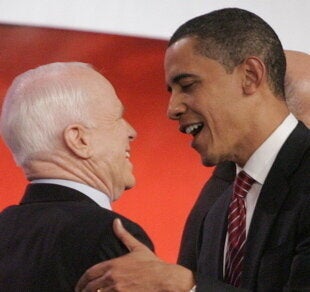
Two election narratives have somewhat paradoxically collided these past two weeks. On the one hand, the shifts in partisan identification and Barack Obama’s determination to change the electoral map have significantly eroded John McCain’s base. On the other hand and despite Obama's shifted strategy, the fact is states that were battlegrounds in 2004 have remained tight, ensuring that McCain remains highly competitive.
Yesterday,5 polls from crucial swing states showed narrow races in the familiar swing states, while other developments underlined the relevance of the new Obama approach, including the unprecedented national scope of his campaign. As the Democrat started running ads in states like North Dakota and Indiana last month, we got out first sense that talk of expanding the map was not just a feint. An analysis of Obama’s campaign organization published by The Hill confirms that Democrats are serious about contesting these states.
Obama has already opened 4 campaign offices in Alaska and 6 in Montana. McCain has no offices in either of these red states. This is a repeat of the primary scenario: Obama’s organized in the caucus states Clinton ignored (Colorado, Alaska, Idaho), gaining a decisive edge in the delegate race. The stakes in the presidential race are different, of course, since electoral votes are not allocated proportionally. But given that no Democratic presidential candidates have opened campaign offices in Alaska or Montana in decades, the mere act of organizing troops in those states could have a dramatic effect on November results. In fact, two polls from red states by Research 2000 confirm that McCain has a lot to worry about:
- In Mississippi, McCain leads 51% to 42% - versus a 15% lead in May. Obama gets 19% of the white vote. He will need to improve that share a bit as well as boost black turnout. (The poll is made up of 37% of African-American respondents versus 35% in 2004.) One positive note for Obama: 15% of the poll’s black respondents are undecided versus 3% of white respondents. He has room to grow. (As a reminder: I have been skeptical of Obama’s chances in Mississippi.)
- In North Dakota, this is the second poll in a row (after Rasmussen’s) to find a toss-up, with McCain up 45% to 42% within the margin of error. This is a state Obama is actively competing in.
As if to confirm its intent to fundamentally alter the rules of the game, the Obama campaign finalized the first national advertisement buy by a presidential campaign since 1996. That year, Bob Dole aired a single national ad. This year, Obama has bought an expensive $5 million package of spots to be aired during the Olympics. In an age in which presidential election play out on a select number of battlegrounds, campaigns do not see the utility of buying time nationally on broadcast television for they are then paying to have their ad seen by voters in Rhode Island and Wyoming, Kansas and Illinois, New York and California - none of them states that Obama and McCain are preparing to contest.
Some will say that the Obama campaign is wasting its resources. Why spend anything on Montana when it is much more important to win Colorado, Iowa and New Mexico and thus get to 273 electoral votes -- whatever the popular vote margin? Three days ago, I explained that Obama’s gambit is very much a win-win move: Either McCain does not respond and opens no offices, runs no ads in MT, AK and NC and Obama’s chances in those states risk becoming even better than in Virginia and Colorado; or McCain responds and divests his limited resources away from states like Virginia and Colorado, leaving those more vulnerable.
It looks like there already are signs that the unlikely erosion of the GOP electoral base is forcing McCain to invest time and money -- a victory for Obama. McCain has been campaigning in… Arizona this month, staging campaign events and directing his staff to pay attention to the state. This is startling given that Arizona is a lean Republican state to start with and it is McCain’s home state. There have been hints for a while that Arizona could be closer than expected, but keep in mind that this isn’t even one of the states Obama has been investing in.
And keep in mind that the Obama campaign has substantially more resources, so that it can spend in Alaska and Montana while also heavily investing in the more traditional battleground states. In fact, The Hill’s article emphasizes just how big an organizational edge Obama is gaining in states in which McCain is supposedly concentrating in: By the end of the week, Obama will have 18 offices in Ohio and 20 in Virginia, compared to 8 and 6 for the McCain campaign! In Missouri, Obama is planning on sending 150 paid staffers and has 50 presently; McCain is described by The Hill as only having “a handful” and planning for 50.
These organizational discrepancies will have a very concrete effect come Election Day: they will impact voter registration, turnout and enthusiasm. These factors might not be determining in blow-out elections, but in close campaigns they can easily account for the 1% to 2% differential that could have gotten Al Gore and John Kerry in the White House. In 2004, the Kerry turnout operation in Ohio ended up being swamped by Bush’s, and that alone appears to have swung the election towards the Republican.
Read more at Daniel Nichanian's blog, Campaign Diaries.